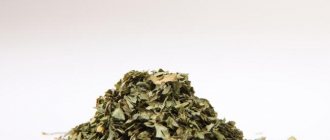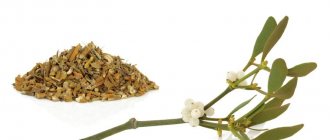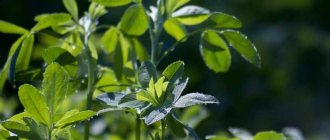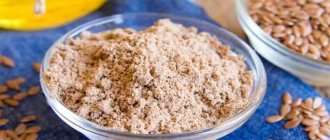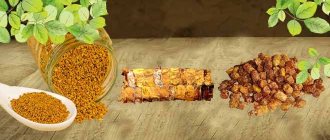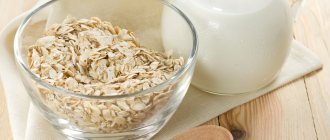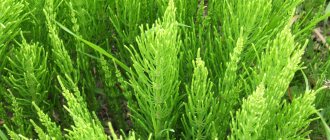Mistletoe White (Willow) medicinal properties and contraindications
Quite an interesting plant, which people call differently: Willow, White, Willow.
In our herbal pharmacy they will understand you, but which of these three names to use is up to you. This plant is familiar to people as a strong drug that relieves inflammatory activities, which include:
- tumor processes (up to malignant);
- inflammation of the kidneys, gastrointestinal tract, uterus.
With the support of this natural specimen, many diseases are successfully cured, which, as well as the medicinal properties and contraindications of White Willow Mistletoe, will be discussed in more detail later in the text.
Description of the plant
Mistletoe is an evergreen parasitic plant of the Mistletoe family. Lives on deciduous trees, less often on coniferous trees and shrubs. Shoots and leaves are poisonous. In appearance it resembles a large spherical nest, the branches of which reach a height of 50 cm.
Instead of roots, a system of suckers develops that penetrate the bark of the host tree. It blooms in March-April, the berries ripen in September-October. The berries, similar to white currants, are eaten with pleasure by birds, especially blackbirds. The pulp of the berries is slimy and sticky, so birds are forced to constantly clean their beaks on the branches.
Thus, the plant “moves” to other trees. Distributed throughout Western and Central Europe, the Caucasus, and Asia Minor. Other names: oak berries, bird glue, shulga, salvation grass.
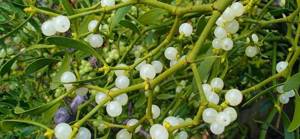
The branches and leaves of mistletoe, which contain:
- amorphous substance viscotoxin;
- natural poison-pesticide lectin;
- tannins and resins;
- organic acids: oleanolic, ursolic, linoleic, palmitic, caffeic, chlorogenic;
- alcohols: pinite, inositol;
- vitamins C, A, E;

- terpenoids;
- triterpene saponins;
- alkaloid-like substances: choline, acetylcholine, propionylcholine;
- mineral salts;
- flavonoids: quercetin, isorhamnetin.
A substance similar to rubber was found in the berries.
Pharmacological properties
Features of Mistletoe from herbal pharmacy
- Relieves inflammation;
- tones and strengthens the body;
- famous for its effects that can stop bleeding, relieve inflammation, kill foreign microbial environments, and inhibit the development of tumors;
- relevant for calming the central nervous system, helping to extinguish increased excitability;
- strengthens the heart, dilates and cleanses blood vessels;
- Effectively renews strength, relieves irritability, relieves headaches and tinnitus.
You already know how much it costs, and now you can order White Mistletoe - Willow online in a store, or simply by calling us at the herbal pharmacy.
How to collect and store a plant
- Harvesting is carried out in late autumn or winter, when the balls of grass are clearly visible against the background of trees without foliage.
- In order to lower and tighten the branches, long hooks are used.
- Branches are prepared with a thickness no thicker than a pencil.
- The plant is removed from the branches entirely and dried in a warm place. Store in places inaccessible to children.
- Raw materials are a “delicacy” for midges and moths, which quickly render them unusable. To protect the grass from pests, it is recommended to add a couple of drops of lavender oil to the lid of the storage container.
Share in the comments what medicinal properties of mistletoe you know about. Perhaps you are familiar with the beautiful Christmas rituals associated with it?
Indications for use
- Inflammation of the gastrointestinal tract, uterus, kidneys;
- diseases of the cardiac system and blood vessels (hypertension, atherosclerosis, vascular dystonia, varicose veins)
- epilepsy, convulsions, hysteria, neuralgic disorders;
- malignant cancers;
- diabetes;
- diseases of the pancreas, thyroid gland;
- respiratory system diseases (tuberculosis, asthma)
- disorders of the sexual and urinary subsystems (enuresis, potency)
- bleeding (any location).
There are also methods that involve using Mistletoe (willow) for weight loss, but personally, from our experience, we recommend using ground Hellebore root for these purposes.
Contraindications
The effects of mistletoe preparations on the body of pregnant, lactating women and young children have not been studied. So it’s better not to take risks and limit yourself to medications that have been tested and prescribed by a doctor.
A list of diseases for which contraindications and side effects outweigh the list of beneficial properties of mistletoe:
- asthenia, low blood pressure;
- suppression of thyroid function;
- tendency to allergic reactions.
Taking medications incorrectly causes poisoning. When drugs enter the stomach in high concentrations, nausea, vomiting, and dizziness occur.

In addition, toxins can accumulate in the body, so it is necessary to strictly follow the doctor’s instructions and not self-medicate.
Method of use
Dry herb, weighing 5 grams, is approximately one tablespoon, boil in a water bath for a quarter of an hour. After removing from heat, leave for about 1 hour. After straining, carefully squeeze out the wet residue. The prepared decoction is strictly 2 tablespoons, three times a day, some time before meals (it is advisable to choose a 20-minute interval).
If you want to make a solution for lotions, then take 60 g of herb per 1 liter of water. The cooking process remains the same, as described in the diagram above.
Mistletoe poisoning. Mistletoe. A parasitic plant that benefits humans

Who among us has not observed spherical formations of dark green color that are found everywhere on deciduous trees? This is mistletoe, a long-lived (since it can reach forty years of age), evergreen shrub, the size of which is about one meter in diameter.
It is not difficult to distinguish a mistletoe bush from all other plants, since it inhabits the tops of trees and, gradually growing, parasitizes, turning the crown into thick round balls.
Mistletoe has never touched the ground and does not know what soil is. Most often, trees such as maple, willow, linden, chestnut, aspen, and poplar become victims of the parasite. The soft bark of these species, when mistletoe seeds fall on it, allows its root system to easily infect the plant and gradually penetrate deeper into the wood. The root of the parasite has the appearance of a haustorium and over time forms a branched system of sap-pulling shoots on the “host”.
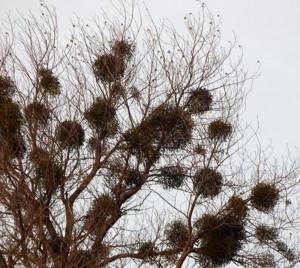
Sometimes mistletoe settles on the branches of fruit trees, for example, on apple and pear trees, and has even been seen on some conifers.
Description
Mistletoe in its diversity is widespread throughout the world, but its most famous species is white mistletoe (lat. Viscum album).
The stems of the shrub are gnarled, gnarled, and the narrow, thick, paired leaves have well-defined longitudinal veins.
Mistletoe blooms in March - April, when at the ends of its shoots (in the forks of the stem) small and unsightly-looking flowers of a yellowish-green hue appear in the amount of three to six pieces. The flower of the plant is unisexual.
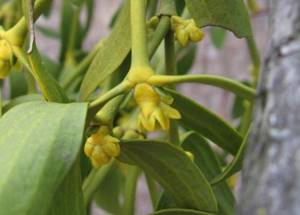
The mistletoe fruit is a spherical, “sessile” green berry. When it ripens, it changes color to milky white. The seeds inside the berry look like gray hearts in shape, covered with sticky mucus (a substance called viscin).
The percentage of seed germination in the plant is extremely low, and the prerequisites for their normal development are optimal air temperature, good lighting and high humidity.
To obtain both male and female mistletoe, which is necessary for the formation of fruits, several seeds must fall on the bark side by side and at the same time.
Females begin to bear fruit in the fifth year of life.
Special Recommendations
It is advisable to combine the reception with Sophora of Japan. It is this that has a beneficial effect on the elasticity of the vascular system. To make it more convenient for you to use these two components, our herbalists have developed a tincture of Mistletoe and Sophora, which you can order in our online store. Call and find out more about this issue
To order, just call this number: 8(800) 511-74-02 (Call within Russia is free)
Or just leave your phone number and we will call you back:
Useful properties of mistletoe
The chemical composition of mistletoe is truly unique. Preparations based on the plant have the following effects on the body:
- hemostatic;
- wound healing;
- hypotensive (lowering blood pressure);

- sedative;
- laxative;
- anthelmintic;
- diuretic;

- pain reliever;
- antisclerotic;
- enhancing lactation;
- antiseptic.
The herb not only has a calming effect, but also has a beneficial effect on the nervous system. Herbal preparations eliminate anxiety, sleep disorders, and irritability.
Application in medicine
For medicinal purposes, Mistletoe is usually used to normalize the functioning of the heart and blood vessels, including hypertensive symptoms and atherosclerosis. Mistletoe-based products help lower blood pressure, have a calming effect, dilate blood vessels, relieve sleep disorders, improve performance and the general condition of patients.
Mistletoe has a positive effect on the nervous system, reduces excitability, and is recommended for the treatment of hysteria, epilepsy, hypochondria, and other disorders of nervous activity, including seizures.
It is known that Mistletoe exhibits a powerful hemostatic effect and can be used to stop uterine, gastric, pulmonary and other bleeding. As an external remedy, Mistletoe is effective when it is necessary to speed up the healing of wounds, ulcers and abscesses; it has a good anti-inflammatory effect. For skin diseases, muscle soreness, radiculitis, Mistletoe lotions have a healing effect. for digestive disorders, herbalists recommend Mistletoe preparations as an effective natural medicine that helps relieve abdominal pain, improves intestinal motility, has an astringent effect and promotes diuresis, and is good for kidney diseases, including nephritis.
Research shows that white mistletoe helps fight malignant cells and also prevents the development of metastases, so it is actively used in the treatment of neoplasms; there is even a direction of so-called “Mistletoe Therapy”.
Infusions, decoctions, tinctures and other types of extracts from Mistletoe are recommended for use for various ailments of the female genital area. In traditional medicine of some peoples, it is believed that fresh Mistletoe juice helps cure infertility. Baths with mistletoe decoction are a good remedy for the treatment of hemorrhoids; they are prescribed for the treatment of inflammatory processes in the female reproductive organs. Mistletoe helps reduce the amount and duration of menstrual bleeding and fights fibroids. Also, the active biological substances of Mistletoe help to activate metabolism in the body, increase diuresis, promote the removal of harmful substances from the body, dilate and strengthen blood vessels.
White mistletoe for oncology. Mistletoe against cancer: myth or reality?
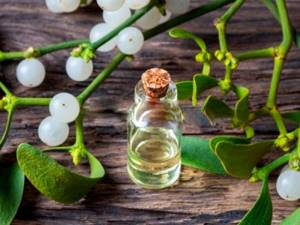
When we feel bad, people close to us get sick, we clutch at every straw, not noticing that it is sometimes thrown over an abyss.
And when it comes to such a terrible disease as cancer, it seems that all means are good. But is it worth neglecting the recommendations of official medicine and following dubious advice? Recently, pharmacies have increasingly begun to ask for mistletoe extract. At the same time, many are sure that this is perhaps the only cure for cancer. Is this so, let's try to figure it out.
mistletoe
Mistletoe is an evergreen coniferous plant, a kind of parasite of the plant world, growing on host trees such as pine, oak, birch and apple. She receives water and minerals at the expense of the “owners”. The scientific name of mistletoe is Viscum album (European mistletoe). This is a poisonous, toxic plant, and its berries are especially dangerous. How can a dietary supplement be found under the name Iscador.
Danger is in trust
If we talk about folk medicine, mistletoe preparations in Europe have been used by healers for many centuries - to treat epilepsy, infertility, hypertension and arthritis, as tinctures, infusions and in combination with other herbs. In the writings of Gaius Pliny Secundus, author of Natural History, there is a description of the use of mistletoe by the Celts.
But in the 20s of the last century, the Austrian Ph.D. Rudolf Steiner suggested that since mistletoe is a parasite, why not use it to destroy the same parasite - cancer cells. Oddly enough, this theory received a pharmacological continuation.
Carefully selected, crushed and then mixed with water, the mistletoe is fermented with lactic acid for three days to extract the desired ingredients. The resulting drugs do contain several toxic proteins that can affect cancer cells. And the boom began.
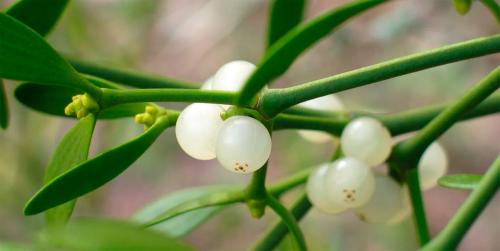
The production of mistletoe preparations was put on stream. But in 2006, an analysis of the use of mistletoe was published in the English scientific publication British Medical Journal. The editorial, titled “Mistletoe as a treatment for cancer has no proven benefit it, and can cause harm,” was authored by a university professor of complementary medicine in Exeter, England.
The reason for writing the article was the fact that patients with cancer really hope for an improvement in their condition and perform injections of mistletoe extract. But only a few recover, while thousands suffer from the side effects of the drug.
Every year in Europe the sales turnover of mistletoe extract is about 45 million euros, and in Germany the cost of treatment with the corresponding drugs is reimbursed by insurance companies. Yes, indeed, many plants have the ability to “kill” cancer cells, but not all of them can be used to create medicines. For example, vincristine and vinblastine were obtained from periwinkle, taxol - from yew berry (cytostatic anticancer drugs - Ed).
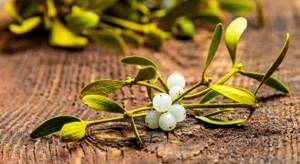
But is mistletoe really effective? The fact of the matter is that the mistletoe extract did not pass the clinical trials required for any medicinal product; more precisely, the result was twofold. Only one thing was certain: the use of mistletoe extract has been proven to be of no benefit, and in some cases, obvious harm has been proven.
So the author of the article strongly recommended against using mistletoe extract in the fight against cancer. But it cannot be denied that mistletoe is successfully used to treat hypertension, gynecological problems, headaches, and neurosis. Crushed branches in the amount of 1.5 teaspoons (10 g) can be brewed with a glass of boiled water and taken two tablespoons in the morning and evening.
Weak elderly people drink mistletoe tea to raise their vitality, and anyone can drink it if they are dizzy. But remember about the high toxicity of mistletoe and do not overuse it. It should not be used during pregnancy either.
Cost of mistletoe for weight loss

Mistletoe is used not only in folk but also in traditional medicine. It is added to various capsules and other weight loss medications. Pharmacies sell mistletoe for weight loss, the price is not too high.
For example, dry mistletoe leaves will cost you 60-100 rubles (50 gram box), and capsules - 100-200 rubles for a dozen tablets. Prices may vary depending on region and supplier.
What a miracle Mistletoe is: where it grows, where to buy
And although mistletoe is considered a bush, it is not an independent plant that grows from the ground. Mistletoe is a parasite that settles on other trees, mostly deciduous, rarely on conifers, and it is difficult to see it among the dense needles.
Another thing is deciduous trees. Especially in autumn and winter, when they have already dropped their leaves, you can see such beauty on the branches: unusual olive-green spherical formations with a diameter of one to three meters, pleasing to the eye.
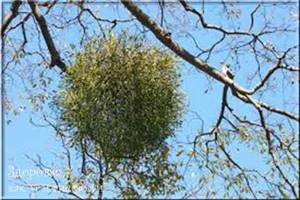
In general, this plant prefers trees with soft wood, into which it tends to invade: apple trees, pear trees, cherry trees, linden trees, maple trees, poplar trees, elm trees, birch trees, pine trees, and fir trees.
If you come across mistletoe on a hazel tree, don’t pass it by! This is a very rare case, as legends say - a treasure is buried under such a tree!
Mistletoe from birch helps with headaches and epileptics, and from pine – for sore joints and the heart.
On trees such as oak, spruce, ash, beech, mistletoe is rarely found. But since ancient times it has been believed that the one on the oak tree has priority over others and has magical powers.
Mistletoe blooms from late March to April with small whitish-yellow flowers, which in summer produce white fruits that smell like orange and are covered with sticky mucus.
Mistletoe is often called "bird glue." Why bird?
The fact is that the seeds stored in mistletoe fruits fully ripen only in winter. Hungry birds, especially blackbirds, love these fruits; in winter they willingly eat them, and the sticky pulp sticks to their beak. To clean their beaks, the birds sit on a tree and excrete undigested seeds in their droppings. Seed grains fall into cracks in the bark, sticking tightly, and then develop in a new environment.
Where does it grow
The habitat of white mistletoe is from the south of Scandinavia and England to southern and central Europe, as well as in northern Asia.
Mistletoe prefers trees near bodies of water, but in Switzerland, for example, it can be found even in the mountains at an altitude of 1200 meters.
And in our Stavropol, mistletoe flaunts right on the central streets of the city.
For your information, red mistletoe grows in the Far East. It differs from white mistletoe only in the color of the fruits, which are reddish-orange in color. The pharmacological properties of these plants are identical. However, I recently read reviews that in the Primorsky Territory the Chinese are buying tons of red mistletoe.
Where can I buy
Mistletoe is practically not sold in pharmacies here, I don’t know how it is in other cities, but in our region it is not, despite the fact that it grows here. You can only collect it yourself. This is due to the fact that the plant is poisonous.
But now it is not difficult to make a purchase on the Internet. I can recommend an excellent online store of medicinal herbs, where I buy everything I need myself. This is not an advertising link, in fact, I really love this site, where you can also get individual practical advice on treatment from the herbalist-healer Dmitry Vyacheslavovich Oleinikov himself.
Currently, the price of mistletoe is 90 rubles per 100 grams.
History and mythology
The mistletoe plant is surrounded by an aura of mystery. Mention of it is found in ancient and Germanic myths. The legends of the northern peoples say that the plant is dedicated to the goddess of love and kissing under the mistletoe has become a folk custom.
At all times, mistletoe has been considered a sacred plant. The ancient Celts idolized it and used it in healing.
In Sweden, a bunch of mistletoe was hung from the ceiling of houses to protect against magic and witchcraft.
In Switzerland it was believed that it protected the tree and the house underneath it from lightning.
And even in our time, mistletoe is revered as a rare plant and a branch is often hung in the house above the door at Christmas.
In France, on the first day of the New Year, children with mistletoe branches go from house to house, congratulating the owners.
Due to such a unique existence in Europe, mistletoe has many nicknames: witch's broom, witch's nest, witch's grass, branch of happiness, holy tree, thunder broom, winter greens.
The scientific name, viscum album, means that it is a white (from the color of the fruit) plant from which glue is extracted.
Reviews of mistletoe for weight loss
Thousands of women have already tested from their own experience whether mistletoe helps with weight loss. Reviews about the plant indicate that this traditional medicine is truly effective even in the most advanced cases, when there is almost no hope of getting rid of extra pounds. Some ladies who were overweight from early childhood managed to lose weight only thanks to willow mistletoe, because no other drugs or exercise helped.
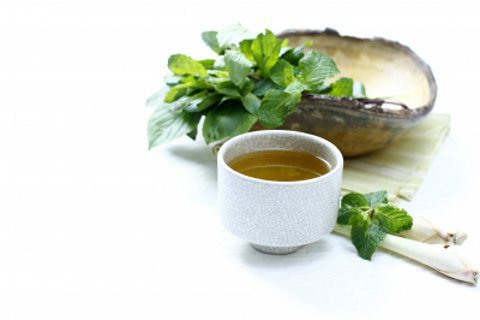
From reviews of mistletoe you can understand the following:
- In the first two days of the course of taking mistletoe and linden tincture, no changes are felt in the body, but in the next day everything changes dramatically: the body feels light, you want to drink more, rather than eat.
- Some women have experienced dizziness from over-consuming mistletoe. Having reduced the dose of infusion, they began to feel much better.
- Without exception, all representatives of the fair half of humanity note that after completing a course of taking mistletoe tincture, the weight does not return, but is fixed.
As you can understand from the reviews, in just four days, mistletoe, a photo of which you can see in this article, will remove fat deposits on the stomach, sides and legs.
Contraindications to the use of mistletoe
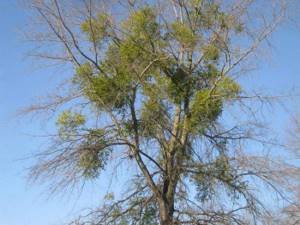
In some cases, a person may experience individual intolerance to a plant such as mistletoe. Contraindications to the use of infusion from this plant are as follows:
- pregnancy and lactation period;
- constant headaches;
- the presence of malignant tumors.
We should not forget that the use of willow mistletoe should not be long-term, because in addition to beneficial substances, the plant also contains harmful components.
Chemical composition
Mistletoe contains substances that are poisonous, so the use of this plant must be carried out taking into account the required dosages. Signs of poisoning may include nausea, diarrhea and vomiting.
At the same time, white mistletoe contains many biologically active substances that have strong medicinal properties. Thus, Alkaloid viscotoxin exhibits activity against tumor cells and enhances the body’s defenses. Triterpene Saponins have a hemolytic effect and increase hemoglobin. Choline, Vitamin B4, has a beneficial effect on the cardiovascular and digestive systems, and acetylcholine is necessary for the proper functioning of the nervous system.
Mistletoe also contains valuable organic acids - gamma-aminobutyric, ursulic, oleic, linoleic, oleanolic, palmitic.
The plant also contains terpenoids, alkaloids, rubber, alcohols, valuable plant flavonoids, histamines, a wide variety of vitamins and minerals necessary for the body.
Features of the medicinal plant mistletoe
The use of mistletoe herb is mentioned in ancient Roman medical treatises. In those days, the plant was most often used to stop bleeding, for epileptic seizures, nervous disorders, tumors, abscesses, and ulcers. How is it used in medicine today?
Area
On what trees can you see mistletoe? These are poplar, willow, birch, rowan, linden, maple, elm, acacia. Less commonly, it parasitizes oak, pine, fir, and walnut. Of the fruit trees, it most often affects apple, plum, and pear trees. The plant is widespread throughout the European part, in the regions of Transcaucasia, the Caucasus, and Asia.
Botanical characteristics

Mistletoe. Botanical illustration from the book "Köhler's Medizinal-Pflanzen", 1887.
What does mistletoe look like? This is an evergreen spherical shrub. Its diameter can be different - from 20 to 120 cm. It settles on deciduous and coniferous trees, loves soft wood. In botany, it refers to semi-parasites: mistletoe is capable of independent photosynthesis, but receives minerals from the tree. It attaches to the bark of a tree using suction cups and is embedded under the bark by its roots. The leaves are narrow, leathery, opposite. The flowers are pale yellow and small. Mistletoe fruits should not be used for medicinal purposes.
Blank
It is important to harvest the plant in an ecologically clean area and not to pick mistletoe from diseased trees.
- Collection. The best time to collect raw materials is autumn and winter. Some herbalists also recommend the spring period (March-April). Collect young shoots along with leaves. They easily break off from the main, thicker branches. If mistletoe “nests” grow high, they are cut off with pruning shears.
- Drying. The plant is dried, spread in a thin layer, on verandas and attics. In damp weather, it is permissible to dry the raw materials in electric dryers at low temperatures.
- Storage. It is best to place dry raw materials in linen bags. The grass is protected from light and moisture and stored for 24 months.
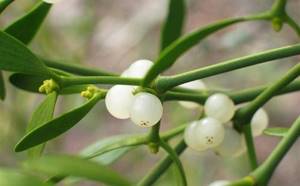
Healing effect
Medicinal properties of white mistletoe:
- sedative;
- painkiller;
- antisclerotic;
- anti-inflammatory;
- hemostatic;
- wound healing;
- vasodilator;
- diuretic;
- hypotensive;
- tonic;
- antitumor;
- restorative.
Chemical composition:
- gum;
- mucus;
- flavonoids;
- terpenoids;
- choline;
- biogenic amines;
- organic acids;
- vitamins and microelements;
- alkaloids.
The plant contains valuable antitumor substances - lectin and agglutinin.
List of indications
What diseases are treated with white mistletoe in folk and traditional medicine?
- Oncology. At the beginning of the twentieth century, the antitumor properties of mistletoe were discovered. Since then, studies have begun to study the effectiveness of mistletoe against cancer. The plant has been proven to stop the growth of malignant cells. Today, mistletoe is successfully used in traditional and alternative therapy as an anti-relapse, supportive, immunomodulating, and restorative medicine. Traditional healers believe that birch mistletoe is especially useful for these diagnoses. There are quite a lot of positive reviews from doctors about mistletoe therapy in scientific medicine.
- CNS. Taken to calm the nervous system, for hysterics, convulsions, headaches, epilepsy.
- Hemostatic agent. Stops uterine, gastric, intestinal, pulmonary, hemorrhoidal bleeding.
- The cardiovascular system. Dilates blood vessels and strengthens the heart muscle. The herb is drunk for high blood pressure, as well as during the rehabilitation period after a stroke, and for angina pectoris.
- Musculoskeletal system. Indications for use: arthritis, osteochondrosis, rheumatism, gout. The product eliminates the inflammatory process and relieves pain.
- Respiratory system. Recommended for the treatment of tuberculosis and bronchial asthma. There is an opinion that for these diagnoses it is better to use mistletoe taken from oak or pine.
- Digestion. The plant has an astringent property and is drunk for diarrhea. Mistletoe is also prescribed as an anthelmintic in combination with other plants. It is most effective against parasites such as pinworms and roundworms. The herb is good for hemorrhoids, intestinal atony, and stimulates peristalsis.
- Benefit for women. Most often prescribed for heavy periods in the premenopausal period, uterine bleeding, uterine fibroids, discharge (leucorrhoea), cervical erosion. The herb is taken internally in the form of decoctions, and used externally in the form of tampons and douches. Some herbalists give recipes for infertility based on mistletoe.
- Normalization of metabolism. The plant prevents the development of atherosclerosis and cholesterol deposition. Mistletoe is often drunk to lose weight and normalize metabolic processes in the body in case of diabetes.
- External use. Used as an analgesic, wound healing, anti-inflammatory agent. The decoction is used to treat wounds, cracks, boils, ulcers, and purulent abscesses. Fresh juice is also applied to sore joints, inflamed lymph nodes, benign and malignant tumors. Take warm baths for hemorrhoids. The medicine is dripped into the ears for inflammation (only after consulting a doctor!).
- Cosmetology. You can rinse your hair with mistletoe decoction after washing. This procedure will enhance their growth and improve their appearance. For problematic facial skin, especially with inflamed pimples and blackheads, the herb acts as a natural antiseptic and quickly relieves inflammation and irritation.
In scientific medicine, in addition to oncology, aqueous and alcoholic solutions are most often used to treat hypertension, intestinal atony, and nervous excitement.
What are the contraindications for mistletoe? Due to its high toxicity, the herb can be dangerous for children, pregnant and lactating women. For chronic diseases of the digestive organs and kidneys, epilepsy and all disorders of the central nervous system, a mandatory consultation with a doctor is required. Prolonged and uncontrolled use can lead to poisoning. Allergies and individual intolerance to the drug are possible.
Mistletoe for weight loss
As mentioned above, mistletoe is a parasitic plant, but despite this, it is used in small doses in both traditional and folk medicine. It has a lot of beneficial properties, but most of all mistletoe helps with weight loss. With the correct dosage, the plant reduces appetite and improves metabolism, so that fats unnecessary for the body do not linger on the body in the form of extra pounds. In addition, mistletoe helps reduce fatigue. So, a person will move a lot and eat as much as necessary (no more, as is often the case with obesity).
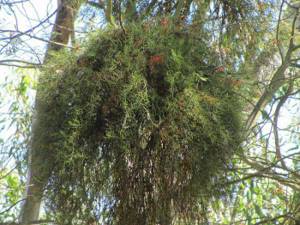
Today, mistletoe is sold in pharmacies in the form of capsules or powder. There are also traditional medicine recipes that can be used at home.
What kind of plant is this?
To properly prepare mistletoe, you need to imagine what it looks like and what it is in general, since the plant is unusual. This is a parasitic shrub growing on another tree. From it the mistletoe receives nutrients for its existence, but produces chlorophyll on its own. The shrub grows in the southern regions, mainly the Caucasus and the Crimean coast. Mistletoe berries are loved by birds, and people have long made glue from them; they used to feed livestock with branches and leaves.
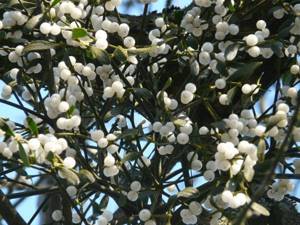
Mistletoe berries
It looks like a round cap attached to the branches of the main plant, the roots pass through the upper layers of the wood and grow deep into it. The diameter of the ball can reach about a meter. The plant blooms in early spring, and the berries are ready in late summer - early autumn, when they acquire a characteristic whitish color.
How to properly prepare mistletoe:
- It is recommended to cut mistletoe grass during the cold season. The smallest amount of harmful components is found in raw materials collected in early spring or after frost.
- You need to use pruning shears to separate the branches and cut them.
- Place or hang the raw materials in a room with low humidity and access to fresh air until completely dry.
- Dried mistletoe is stored in a fabric bag or glass jar. Harvested raw materials can only be used for one year.
The plant is poisonous and its fruits should not be eaten. Even if a person just touched them, they should immediately rinse their hands with clean water.
